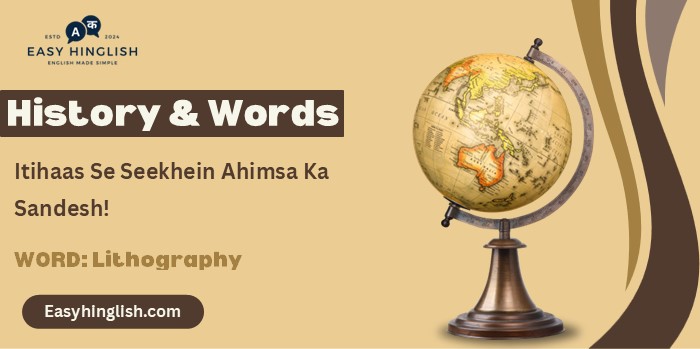History & Words: 'Lithography' (October 25)
Welcome to 'History & Words.' Main Prashant hoon, Wordpandit aur Learning Inc. Network ka sansthapak. Yeh series meri bhasha seekhne ki lagan aur itihas ke prati ruchi ka sangam hai. Har kadi ek shabd aur uss se judi ek tithi par roshni daalti hai, jisse aapka shabdkosh badhta hai aur aap itihas ko gehraai se samajh paate hain. Aaiye, iss safar mein shabdon ke madhyam se samay mein pichhe chalein.
🔍 Word of the Day: Lithography
Pronunciation: /lɪˈθɒɡrəfi/ (li-THOG-ruh-fee)
🌍 Parichay (Introduction)
25 October 1836 ko Paris Patent Office mein history ka ek decisive moment record hua jab Godefroy Engelmann ko mechanical lithographic printing press ka first patent grant kiya gaya. Yeh innovation sirf technical improvement nahi thi – yeh mass communication revolution ki foundation stone thi jo visual information ko democratize kar degi.
Lithography – "stone writing" ka literal meaning – printing technology mein paradigm shift tha. Traditional printing methods mein raised ya recessed surfaces required the, lekin lithography flat surface par chemical process use kar ke printing achieve karti thi. Oil aur water ka natural repulsion ingenious printing method create karta tha.
October 25, 1836 se pehle books, newspapers, maps expensive aur time-consuming the produce karne ke liye. Engelmann ka patent ne industrial scale printing ko practical banaya, information aur visual content ko masses tak accessible kar diya. Modern printing industry, advertising, art reproduction – sab yahan se trace ho sakte hain.
🌱 Shabd ka Utpatti (Etymology)
"Lithography" Greek words "lithos" (stone) aur "graphein" (to write/draw) se bana hai – literally meaning "writing on stone". Term 1798 mein coin hua jab Alois Senefelder ne accidentally discover kiya limestone par printing technique.
"Lithos" ancient Greek se various contexts mein use hota tha – architecture, geology, philosophy mein. "Graphein" root hai graphic, biography, calligraphy jaise words ka. Scientific combination modern innovation represent karta hai.
Evolution interesting hai: "lithograph" (printed image), "lithographer" (person), "lithographic" (adjective) – all terms 19th century mein develop hue technology spread hone ke saath.
📖 Mahatvapurn Shabdavali (Key Vocabulary)
- 🔑 Planographic: Printing from a flat surface (neither raised nor recessed)
- 🔑 Offset Printing: Modern lithographic technique using rubber blanket transfer
- 🔑 Photolithography: Process using light-sensitive chemicals for image transfer
- 🔑 Grease Crayon: Fat-based drawing material used in traditional lithography
- 🔑 Registration: Precise alignment of multiple colors in printing process
🏛️ Itihasik Sandarbh (Historical Context)
Pre-lithography printing mein three main methods dominant the: relief printing (woodcut, letterpress), intaglio (engraving, etching), aur stencil printing. Each method specific limitations aur advantages the, lekin all labor-intensive aur expensive the mass production ke liye.
Alois Senefelder ka accidental discovery (1798) revolutionary tha. Bavarian playwright music sheet printing ke liye cheaper method search kar raha tha jab usne limestone par greasy crayon se writing try ki. Discovery ki oil-based ink water repel karta hai, lekin greasy areas par stick karta hai.
Early adoption slow tha kyunki process skill-intensive thi aur equipment expensive tha. Senefelder ne initial patents Bavaria mein secure kiye, lekin technique gradually Europe throughout spread hui.
Engelmann strategic importance underestimated nahi kar sakte. French lithographer already established tha fine art lithography mein, lekin mechanical press patent ne commercial viability exponentially increase kar diya. Hand-operated presses se steam-powered machinery tak ka transition industrial revolution ka part tha.
1836 significant year tha printing industry ke liye globally. Newspaper circulation increasing kar raha tha, literacy rates improving the, aur urbanization information demand create kar raha tha. Engelmann ka patent perfect timing tha market needs meet karne ke liye.
Competition immediate tha. British, German, American inventors similar technologies develop kar rahe the. Patent race intellectual property aur industrial espionage ka early example tha globalized economy mein.

⏳ Samayrekha (Timeline)
- 1798: Alois Senefelder accidentally discovers lithographic principle
- 1801: Senefelder's first lithographic patents in Bavaria
- 1818: Lithography introduced to France by Senefelder himself
- 1820s: Artistic lithography flourishes (Goya, Delacroix use technique)
- October 25, 1836: Engelmann receives mechanical press patent
- 1840s: Commercial lithography becomes widespread
- 1875: Offset lithography developed
- 1960s: Photolithography revolutionizes semiconductor manufacturing
🌟 Is Din ka Mahatva (The Day's Significance)
October 25, 1836 ko French Patent Office mein Patent No. 11,265 issue hua Godefroy Engelmann ke naam “mechanical apparatus for lithographic printing” ke liye. Patent description detailed technical specifications include karta tha improved press design ka jo consistent pressure, better registration, aur faster production allow karta tha.
Engelmann ka innovation several key improvements include karta tha:
- Mechanical pressure system replacing hand-operated scraper
- Improved stone bed for better ink distribution
- Registration guides for multi-color printing
- Gear system for consistent print quality
Immediate impact Paris printing industry mein visible tha. Publishers quickly adopt kiye new technology especially illustrated books aur periodicals ke liye. Cost reduction significant tha – printing costs 50–60% decrease hue compared to traditional engraving.
Artistic community enthusiastic response diya. Honoré Daumier ne lithographic caricatures create kiye jo political satire aur social commentary ke liye famous hue. Toulouse-Lautrec later lithographic posters use kar ke advertising art revolutionize kiya.
Map-making industry transform ho gayi. Detailed maps quickly aur accurately reproduce ho sakte the, geographic knowledge ko widely available banate hue. Military applications obvious the – battlefield maps rapidly update aur distribute kiye ja sakte the.
Educational impact equally significant tha. Textbooks illustrations ke saath affordable ho gayin, scientific diagrams precisely reproduce ho sakte the, aur visual learning materials mass produce kiye ja sakte the.
International adoption rapid tha. British publishers France se expertise import kiye, German printers technology adapt kiye their markets ke liye, aur American entrepreneurs lithographic businesses establish kiye growing cities mein.
Economic impact broader tha printing industry se. Advertising industry emerge hone laga, commercial art profession ban raha tha, aur visual communication business strategy ka part ban raha tha.
💬 Prasiddh Ukti (Quote)
"The lithographic stone is the most beautiful invention for the multiplication of drawings."
— Francisco Goya
🔮 Aaj Ka Matlab aur Chintan (Modern Usage and Reflection)
Modern lithography dramatically evolved hai Engelmann ke time se. Offset printing – dominant commercial printing method today – direct descendant hai 19th-century lithography ka. Newspapers, magazines, books, packaging – majority offset lithographic process use karte hain.
Most revolutionary application semiconductor industry mein hai. Photolithography – light-based lithographic process – computer chips manufacture karne ke liye essential hai. Moore's Law (transistor density doubling) possible hai advanced lithographic techniques ke through jo nanometer-scale patterns create kar sakte hain.
3D printing aur digital manufacturing new forms of lithographic principles explore kar rahe hain. Stereolithography liquid resin use kar ke layer-by-layer manufacturing achieve karta hai.
🏛️ Virast (Legacy)
Engelmann ka October 25, 1836 ka patent mass communication ka foundation establish kar diya. Modern printing industry, advertising, graphic design, publishing – sab yahan se trace ho sakte hain.
Most unexpected legacy semiconductor revolution mein hai. Silicon Valley ki success partially advanced lithographic processes par depend karta hai jo computer chips precisely manufacture kar sakte hain.
🔍 Tulnatmak Vishleshan (Comparative Analysis)
1836 mein lithography manually intensive process thi requiring skilled craftsmen aur limestone blocks. Today computerized aur automated hai digital files se directly printing plates create kar ke.
Print quality exponentially improved hai – 1836 mein 100 lines per inch good resolution tha, today 2400+ DPI (dots per inch) standard hai commercial printing mein. Color accuracy, registration precision, production speed – all parameters orders of magnitude better hain.
💡 Kya Aapko Pata Hai? (Did You Know?)
🎓 Antim Vichar (Conclusion)
October 25, 1836 ne lithography ko artisanal craft se industrial process mein transform kar diya. Engelmann ka mechanical press patent ne mass communication revolution ki neev rakhi jo today digital age tak continue kar raha hai. Smartphone screen par jo image display hota hai, newspaper jo morning padhte hain, computer chip jo calculations perform karta hai – sab lithographic principles ka evolution hai. Stone writing se shuru hui journey nano-scale manufacturing tak pahunchi hai, proving ki simple discoveries unimaginable transformations lead kar sakte hain.
📚 Aage Padhne Ke Liye (Further Reading)
- 📘 The Art of Lithography – Michael Twyman
- 📗 Stone and Press: The Art of Lithography – Devon Boorman
- 📙 Lithography: 200 Years of Art, History, and Technique – Domenico Porzio








